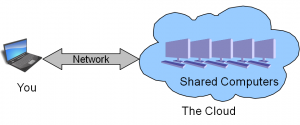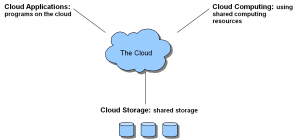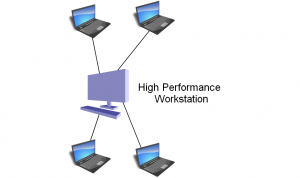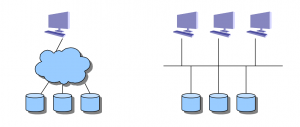Cloud has become a hot term but one that is used extensively without definition. It is often vague and undefined. This leads to another problem: if you ask ten people for a definition, you will undoubtedly get ten widely differing answers. Â Some will be highly technical, others more tangible and understandable. I prefer accessible language and definitions that do not require an entire paragraph. I am going to define the cloud and cloud computing and discuss types of clouds. In an upcoming posts
 I will go into more detail on accessing these types on clouds and more specifics on how you can make use of the cloud, but it is essential to have the basics.
 At a basic level, the cloud is the Internet with a few important differences. It is programs, tools, or services using shared resources over a network. That means you, the user, are using resources that are not on your own computer. Instead, your computer accesses shared resources over a network. These resources could be storage, applications, computing power, etc.
At a basic level, the cloud is the Internet with a few important differences. It is programs, tools, or services using shared resources over a network. That means you, the user, are using resources that are not on your own computer. Instead, your computer accesses shared resources over a network. These resources could be storage, applications, computing power, etc.
You are probably already using the cloud everyday, for example Gmail and Google Docs are cloud applications similar to Outlook or Microsoft Word. What these cloud applications have in common is you are utilizing someone else’s resources (e.g. Google’s storage) with your data and they take place over the Internet.
 I would give three primary examples of cloud usage: Applications, Computing, and Storage. Cloud applications are one use of the cloud (e.g. Gmail, Google Docs, etc.). Cloud Computing is another application of the cloud which employs shared computing resources. There is a clear difference between referring to “The Cloud” and “Cloud Computing.” The Cloud as a noun refers to everything collectively including applications, storage, and computing. Cloud Computing is only a singular aspects of The Cloud, using shared computing resources.
I would give three primary examples of cloud usage: Applications, Computing, and Storage. Cloud applications are one use of the cloud (e.g. Gmail, Google Docs, etc.). Cloud Computing is another application of the cloud which employs shared computing resources. There is a clear difference between referring to “The Cloud” and “Cloud Computing.” The Cloud as a noun refers to everything collectively including applications, storage, and computing. Cloud Computing is only a singular aspects of The Cloud, using shared computing resources.
There are three types of clouds: public, private, and hybrid. Each type has benefits and drawbacks for a firm depending on your unique situation. Public clouds are services available to anyone. They are shared clouds like Amazon EC2, Gmail, etc. The largest benefit is that there is no upfront hardware investment because you only pay for the time or data you utilize. Public clouds are easily scalable because you can quickly add more storage, computing power, and so forth. With these benefits come drawbacks. They can become expensive with heavy usage and can be perceived as “less†secure than an in-house solution. My view is that any computer solution is only as secure as the person who secures them. Perhaps the biggest drawback to the public cloud is the limited flexibility because of the limited hardware configurations available.
 Private clouds are computer or storage systems that are built on your own premises; they are private to your organization. The benefits mirror the drawbacks to the public cloud: more flexibility, lower recurring costs, and arguably more security and control. Likewise, the drawbacks mirror public cloud benefits: larger upfront costs, ongoing maintenance costs, less scalability. Private clouds include in-house IT departments while with a public cloud you are utilizing the IT experts of your service provider.
Private clouds are computer or storage systems that are built on your own premises; they are private to your organization. The benefits mirror the drawbacks to the public cloud: more flexibility, lower recurring costs, and arguably more security and control. Likewise, the drawbacks mirror public cloud benefits: larger upfront costs, ongoing maintenance costs, less scalability. Private clouds include in-house IT departments while with a public cloud you are utilizing the IT experts of your service provider.
A third type of cloud has emerged: the hybrid cloud. A mixture of a private cloud and public cloud, this cloud can take many forms. The most common is maintaining many services in house and off-loading certain services to the public cloud including email (Gmail, Google Docs) and cloud storage.
An example of public and private clouds for a usage many people are already familiar with is storage. Public cloud storage, such as Amazon S3, is accessed via an internet browser. You copy your files to Amazon’s storage – not on your network. It is a publicly available service and has the benefits of a public cloud discussed earlier such as expandability, per-usage pricing, and so forth.
For private cloud storage, which many users probably have in their office in the form of a shared file server, you drag and drop files between your computer and the shared disk drive. Private means private to people within your firm as opposed to a service available to the public. It has benefits including easier access and is more economical for heavier usage.
Another popular usage of the Cloud, after storage, is cloud computing which on a public cloud is computers that you pay for by the hour. This allows you to use high-end workstations without purchasing them. You can easily scale from smaller systems to larger systems. As your needs change, you can scale up to more cores, increased memory or more storage.
 If you have a private cloud, it allows you to pool and share expensive computing resources. Instead of buying high performance workstations for each user, you simply buy a few systems and then each user can access them through Remote Desktop. Also, by only having a few high-end systems, it allows for easier administration.
If you have a private cloud, it allows you to pool and share expensive computing resources. Instead of buying high performance workstations for each user, you simply buy a few systems and then each user can access them through Remote Desktop. Also, by only having a few high-end systems, it allows for easier administration.
Dr. Errin is a principal at Limitless Computing, Inc., a high-performance computing company based in Boulder, CO that specializes in providing cloud computing services to the AEC industry. Before joining LCI, Errin consulted as a remote sensing specialist for NASA and studied ancient Maya architecture.

